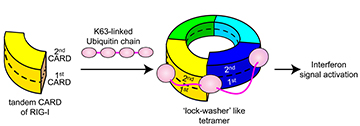
If you follow cancer biology, then you’ve probably heard of ubiquitin before.
Ubiquitin tags a cell’s damaged or used proteins and guides them to a cellular machine called the proteasome, which breaks them down and recycles their amino acids. Proteasome-blocking drugs, like Velcade®, that go after this recycling pathway in cancer cells have been very successful at treating two blood cancers—multiple myeloma and mantle cell lymphoma—and may hold promise for other cancers as well.
Less well known, however, is that ubiquitin helps normal, healthy cells raise an alarm when viruses attack. Ubiquitin works with a protein called RIG-I, part of a complex signaling pathway that detects viral RNA and triggers an innate antiviral immune response.
Sun Hur, assistant professor of biological chemistry and molecular pharmacology at Harvard Medical School and the Immune Disease Institute as well as assistant professor of pediatrics at Boston Children’s Hospital, has been studying RIG-I and other members of the innate cellular antiviral response for some time. In a recent paper in Nature, she provided a structural rationale for how ubiquitin helps RIG-I do its job—and how that might help keep the immune system from getting out of hand.
Using a technique called X-ray crystallography, Hur and post-doctoral fellow Alys Peisley showed that ubiquitin helps RIG-I gather into stable rings that look like lock washers. Each ring is made up of four RIG-I proteins, together forming a single unit called a tetramer. The rings form platforms where other molecules can gather and help tell the cell to start producing the antiviral protein interferon.
But as Hur points out, there are two ways ubiquitin can hook onto RIG-I. If ubiquitin hooks on one way, as something called a K63 chain, then RIG-I can sound the alert. If ubiquitin hooks on the other way, as a K48 chain, then RIG-I is simply recycled by the proteasome like any other protein.
“RIG-I attaches to RNA from viruses, but that’s not enough by itself to trigger an antiviral signal,” she explains. “You need ubiquitin binding and tetramer formation before you see a response.”
Hur speculates that the need to form the ring may help prevent inappropriate immune responses.
“It may be a way of regulating RIG-I and the innate antiviral response,” she says. “The cell wants to wait until it’s sure that there is a viral infection before activating the response, otherwise it risks ending up with systemic inflammation. So this may help keep the checks and balances in place.”
The work was funded by a GSK fellowship, The Welch Foundation (I-1389), the National Institutes of Health (R01-GM63692), a Pew Scholarship and a Career Development Award from Boston Children’s Hospital.
Adapted from an article in Vector, Boston Children’s Hospital’s science and clinical innovation blog.


